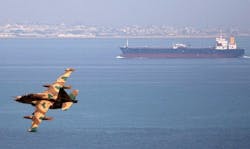A reminder of how tensions in the Persian Gulf quickly could escalate out of control
I know, we hear that all the time, and everything's still okay, right? Oil is $36 a barrel, and gas at the pump is less than $2 a gallon. Things are good; why worry?
Well, let's connect the latest set of dots.
Saudi Arabia severed diplomatic relations with Iran on Monday. History tells us this kind of action can be a prelude to war. It's not a given that Saudi Arabia and Iran will resort to armed conflict, but the official cutoff of diplomatic relations is a serious escalation of tensions.
Saudi Arabia and Iran both are major crude oil producers, and face each other across the Persian Gulf. What separates these two nations, however, is much more than a body of water. The two countries are serious economic, political, military, and religious competitors.
Related: U.S. commanders assess technological lessons learned of Gulf War II
The biggest divide separating the two countries involves competing branches of the religion of Islam. Saudi Arabia represents the Sunni branch of Islam, while Iran represents the religion's Shia branch. Sunni and Shia Muslims don't simply disagree with one another; each side believes the other is wrong to the point of evil. It's a religious divide that has been brewing for 14 centuries.
Separately, leaders in Saudi Arabia worry about how terrorism threatens the stability of their kingdom, so in that country suspected terrorists are treated harshly. On Saturday Saudi Arabia executed 47 people on terrorism charges, including a Shia religious leader who had spent a decade studying theology in Iran.
These executions angered Shia adherents in Iran, who retaliated by attacking the Saudi Arabian embassy in the Iranian capital of Tehran. That's when Saudi Arabia severed diplomatic ties with Iran and gave Iranian diplomats in Saudi Arabia 48 hours to leave the country.
So here we have heavily armed Saudi Arabia and Iran glowering at each other across the Persian Gulf -- the transportation route for 20 percent of the world's crude oil. Saudi Arabia has world-power backing from the U.S., and Iran has backing from Russia. It's not clear how other global military powers like China, India, and the European Union might align in a Saudi-Iranian military conflict.
So what happens if the worst happens and a diplomatic conflict turns into a shooting war between Saudi Arabia and Iran? It wouldn't take much ... perhaps just one anti-ship missile that sinks a Saudi or Iranian tanker in the Strait of Hormuz where the Persian Gulf meets the Arabian Sea. Such an incident could ignite a war that could close the Persian Gulf to oil traffic for months, if not longer.
Overnight, if that happens, we probably would see gasoline prices double, as crude oil prices headed well north of $100 a barrel. How long oil prices would remain that high depends on how much commodity traders fear a prolonged oil supply disruption in the region.
If ships are sunk in the Strait of Hormuz and the Persian Gulf closes indefinitely, then oil prices will go up and stay up. If there were to be only a short disruption then oil prices would spike quickly and then come back down to current levels. No telling how such shocks to the oil market could influence the U.S. and world economies.
Should Saudi Arabia and Iran refrain from armed conflict, an economic war could ensue. Saudi Arabia may choose to hurt the Iranian economy by flooding the world market with even more oil. If that happens, watch oil prices sink to $16 a barrel and gas prices approach $1 a gallon.
A full-blown Saudi-Iranian war, however, could have more far-ranging effects than the price of oil. How closely would such armed conflict draw the world powers to the brink of war? The U.S., Russia, and China in recent years have not been shy about brinkmanship; A Saudi-Iranian war would lure world military forces into a very dangerous game.
Related: How vulnerable are U.S. Navy vessels to advanced anti-ship cruise missiles?
I'm reminded of accounts of the summer of 1914 in Central Europe. The continent hadn't seen a major war in 100 years, was heavily armed, and spoiling for a fight. Alliances had Britain, France, Russia, and Serbia on one side pitted against Germany, Austria-Hungary, and the Ottoman Empire on the other.
On 28 June 1914 a Serbian terrorist in Sarajevo assassinated Archduke Franz Ferdinand, heir to the throne of Austria-Hungary. A month later, Austria-Hungary severed diplomatic ties with Serbia, and declared war the next day.
Within the next 10 days, interlocking alliances persuaded Germany to invade France through Belgium. What happened next we know of as World War I.
It's unlikely that today's political rift between Saudi Arabia and Iran will reach dire proportions like this, but the past tells us that cataclysmic consequences can result from what appear to be minor incidents. World leaders must remember how quickly things can escalate out of control.

